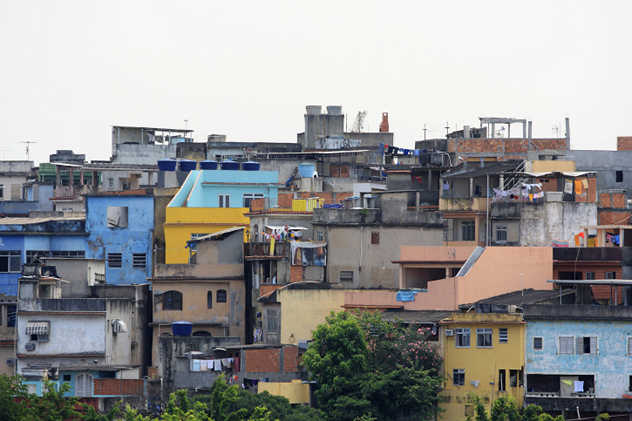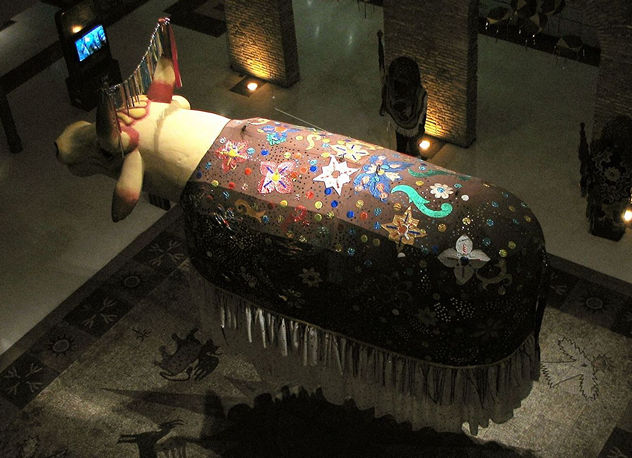 Music
Music  Music
Music  History
History 10 Less Than Jolly Events That Occurred on December 25
 Weird Stuff
Weird Stuff 10 Funny Ways That Researchers Overthink Christmas
 Politics
Politics 10 Political Scandals That Sent Crowds Into the Streets
 Weird Stuff
Weird Stuff Ten Bizarre Facts About The Doge Meme
 Our World
Our World 10 Ways Your Christmas Tree Is More Lit Than You Think
 Movies and TV
Movies and TV The 10 Coolest Stars to Set Sail on The Love Boat
 History
History 10 Things You Didn’t Know About the American National Anthem
 Technology
Technology Top 10 Everyday Tech Buzzwords That Hide a Darker Past
 Humans
Humans 10 Everyday Human Behaviors That Are Actually Survival Instincts
 Music
Music 10 Surprising Origin Stories of Your Favorite Holiday Songs
 History
History 10 Less Than Jolly Events That Occurred on December 25
 Weird Stuff
Weird Stuff 10 Funny Ways That Researchers Overthink Christmas
Who's Behind Listverse?

Jamie Frater
Head Editor
Jamie founded Listverse due to an insatiable desire to share fascinating, obscure, and bizarre facts. He has been a guest speaker on numerous national radio and television stations and is a five time published author.
More About Us Politics
Politics 10 Political Scandals That Sent Crowds Into the Streets
 Weird Stuff
Weird Stuff Ten Bizarre Facts About The Doge Meme
 Our World
Our World 10 Ways Your Christmas Tree Is More Lit Than You Think
 Movies and TV
Movies and TV The 10 Coolest Stars to Set Sail on The Love Boat
 History
History 10 Things You Didn’t Know About the American National Anthem
 Technology
Technology Top 10 Everyday Tech Buzzwords That Hide a Darker Past
 Humans
Humans 10 Everyday Human Behaviors That Are Actually Survival Instincts
10 Brilliant Facts About Brazil
Brazil’s got the eyes of the world on it at the moment. It’s due to host the soccer world cup in 2014, with the Olympics to follow in Rio two years later. Yet repeat blackouts, unfinished stadiums, and massive protests against corruption have left many people concerned. On the other hand, the Brazilians know how to throw a party, and their pubic hair is impeccable. With this South American giant predicted by some to be one of the world’s next super powers, now’s a good time to get yourself acquainted.
10The Knitting Prisoners
Arisvaldo de Campos Pires is a maximum security prison, 160 kilometers (100 mi) from Rio de Janeiro. It’s the sort of prison where guards wear balaclavas and carry shotguns, but also home to much more homely scenes. The Lotus Flower Project was the brainchild of a Brazilian fashion designer, Raquel Guimaraes, who was suffering a shortage of knitters. She’d had a run of success and needed to increase production, and decided some of the country’s toughest criminals would be just the fit.
Prisoners get paid 75 percent of Brazil’s minimum wage, with a quarter of their earnings kept aside until they get out. They also get a day knocked off their sentence for every three days spent crafting high fashion out of wool. Learning a skill, getting used to working, and having some cash on release offer clear advantages for taking people out of the situation where they may offend again.
9Nazis In Brazil

While we can all agree the Nazis had their faults, they were nothing if not ambitious. Their desire for world domination didn’t stop with Europe and Russia, they had their sights further afield. In 1935, a Nazi expedition scouted the Amazon rain forest in Brazil, close to its border with French Guyana, to investigate setting up an outpost. One of the members of the team died during the mission, and a 2.8 meter (9 ft) cross stands in the rain forest, with the inscription “Joseph Greiner died here on 2.1.1936, a death from fever in the service of German Research Work.”
The party was led by an SS Officer, Dr. Otto Schulz-Kampfhenkel. He thought settling in Brazil held much promise, and told Himmler “for the more advanced white race it offers outstanding possibilities for exploitation.” The project was scrapped when Himmler lost interest, yet that was far from the end of Brazil’s links with the Nazis. Brazil was very fascist friendly, and many Nazis fled there when the war was over. In 1997, a safe of a deceased German immigrant, Albert Blume, was found in Sao Paolo, containing $4 million worth of war treasure stolen from Jewish families.
The Nazi “Angel of Death,” Dr. Josef Mengele, is the most infamous person to have set up home in Brazil after the war. His presence spawned an urban legend about the town of Candido Godoi. The remote Brazilian settlement has an unusually high incidence of twins, and people have suggested experiments by Mengele are to blame. This has turned out to be a myth—the locals were having a lot of twins before he got there, and continued doing so after Mengele’s death—and the twins from the village get understandably annoyed about the suggestion they’re the result of a Nazi experiment.
8Favela Tourism

Rio de Janeiro is famous for its shanty towns. The favelas are home to a fifth of the city’s population, meaning 1.4 million people call them home. A large collection of people amassed in poverty tends to not be a breeding ground for opportunity. Brazil’s favela residents were often forced to a life of crime, making the favelas notoriously dangerous.
The Brazilian government has made an effort to clean up the towns in recent years. This “pacification” program involves moving in police to tackle the drug gangs, and improving the infrastructure with new buildings and safe pathways. A decent concrete staircase can make a big difference in your life, when you’re living on the side of a 1,000 meter (3,300 ft) mountain. The program has worked, and in doing so it’s created a brand new industry—favela tourism.
The first favela to be pacified was Santa Marta. Today, some residents of the area work as tour guides, showing people around for a fee. The homes, many built from cinder blocks and wood, retain their shabby appearance from the outside. Inside, they have flat screen TVs and fitted kitchens. Celebrities, including Madonna and Beyonce, had paid a visit to have a look around the reformed slums.
7Favela For Dogs

It’s not only people that get to live in sprawling, ramshackle towns on a hillside. The city of Caxias do Sul has a favela with hundreds of buildings, which is home to nothing but dogs. It was created by an animal welfare charity called So Ama—Portuguese for “Just Love”—that lacked funds to build a proper shelter. They house 1,600 animals, each one chained to a shack. The animals get through 13 tons of food each month.
Unfortunately, most people are only interested in adopting purebred puppies. The older mongrels have no such luck. The charity is struggling, as it needs to spend more to care for the animals than it receives in donations or government help. The founder says she sometimes feels ashamed about the inability to provide a proper animal shelter, but the other option would be to turn dogs away to live (or die) on the streets.
6Fishing With Dolphins
The Brazilian city of Laguna is home to one of the planet’s most impressive alliances between humans and other animals. The local fishermen begin their day by wading into the sea, nets in hand, and waiting for their assistants—dolphins—to arrive. It’s too murky for people to see below the surface, but dolphins know where the fish are. When the fishermen use the dolphins’ instruction to cast their nets, the catches are large. If the dolphins aren’t around, the locals say it’s not worth bothering.
No one knows exactly how the tradition started, or exactly what’s in it for the dolphins. It’s been suggested that the presence of nets confuses the fish, and the dolphins are able to catch larger (and usually faster) specimens. Whatever the reasons, the dolphins seem keen, as the same ones return regularly to take part. The fishermen can even identify individuals by name. Ultimately, it seems to be a winning situation for everybody—except, of course, the tasty, tasty fish.
5Bumba-meu-boi

If you wanted to arrange a carnival and could pick any country to be on the organizing committee, you’d probably go for Brazil. It’s famous for its bright parades in Rio, but the iconic Carnaval do Brasil isn’t the only awesome street party. Another awesome parade is Bumba-meu-boi. It’s particularly popular in the north of the country, and the parade is based around an unusual folktale.
While there are differing versions, the basic premise is the same. A wealthy farmer hires a young farmhand to look after his ox, which is the grandest beast in the land. The farmhand’s pregnant wife develops a craving for ox tongue, so the farmhand slaughters the beast he’s looking after, in order to satisfy his wife. The farmer gets angry (fair enough) and decides to kill the farmhand. With the help of villagers and an intervention from St. John, the peasant brings the ox back to life using drums. The farmer then forgives him (because it’s never wise to mess with people showing godly powers, even if you’re their employer).
In Sao Luis, 200 different teams put together ox costumes and battle it out to create the most impressive reenactment of the event. The crowd is encouraged to heckle the bad guy in all this—not the magical ox murderer, but the farmer. The moral of the story is, presumably, that it’s okay to kill the thing you’re being paid to look after, so long as you can use a funky beat to resurrect it afterwards.
4Casa de Pedra
It’s not just the government that can brighten up a favela. One man, Estevao Conceicao, spent two decades converting a nondescript slum building into an eclectic cave of treasures. Stone archways are lined with plates, dolls, mobile phones, typewriters, motorcycle helmets, shoes, and pretty much everything else. As well as becoming a celebrity in Paraisopolis, the Sao Paulo shanty town where he built it, it also got him a trip to Spain.
Conceiacao’s Casa de Pedra (or “House of Stone”) caught the eye of a visiting architecture student. It reminded him of the work of a famous Spanish-Catalan architect, named Antoni Gaudi. The Center For Gaudinist Studies agreed, and flew Conceicao to see the architect’s work. Conceiacao agrees that they’ve got a similar style, but he had never heard of Gaudi when he began. He shaped his house around a tree that was growing in the middle of it, and added to it organically over the years.
3Sambaqui

It’s been pretty much settled that the Egyptian pyramids couldn’t have been built by humans. As the many people reading this via the assistance of satellite will no doubt attest, mankind is incapable of getting heavy objects very high up. Yet, while it’s obvious the Egyptians must have had help from werewolves on broomsticks to move stone about, the native population of Brazil had a pyramid building strategy that even the History Channel is unlikely to blame on aliens or fairies.
Sambaquis are mounds of shells, dirt, and bones that were built as far back as 8,000 years ago. For a long time, academics thought they were simply rubbish heaps that got out of hand, to the point that the tallest reached a height of 50 meters (165 ft). More recent research suggests they were actually built on purpose, making them the world’s oldest pyramids. Only 10 percent of them are left, as many were stripped for road building material. Of their many possible functions, there’s good evidence they were used during funerals and to bury the dead (much like their Egyptian counterparts). Altogether, they suggest a more sophisticated ancient culture than we previously knew.
2Indigenous Firefighters
Everyone is aware of the threat of human deforestation against the rain forest, yet there’s a bigger threat from nature itself. Each year, much more forest is destroyed by naturally occurring fires than by man. The problem with fighting fires in the Amazon is that it’s very big—in Brazil alone, the rain forest covers an area six times the size of Texas. That means one fire crew of five men can be tasked with covering an area the size of England by themselves.
There’s only one way to tackle flames in the undergrowth: beat them with a stick until they go out. The oppressively humid forest hovers around 27 degrees Celsius (80 degrees F) without raging fire. On top of that, firefighters might need to machete their way through the trees for a couple of hours, before they even get to the blaze. All those things mean rural Brazilian firefighters need to be in spectacular physical condition.
Because the firefighters lack the ability to be everywhere at once, they need help. They have turned to warriors from indigenous tribes that live deep in the forest. The locals are more than happy to swap their usual dress of nothing-but-a-loincloth for full-body overalls and a gas mask, and get right into the action.
The firefighters provide training as well as equipment to the natives, so that if a fire crops up near their village, they can put it out before it becomes a problem. The cattle industry, traditionally a cause of deforestation, has tried to make amends by providing private funding to similar projects. The United States Forest Service have also offered their assistance and expertise in visits to the forest.
1Japanese Brazilians

Back in the early 20th century, Japan was fearing a population crisis. Increasing industrialization and people moving to the cities led to fears of sparse resources, so the government chose to promote emigration as a policy. Hundreds of thousands of Japanese left, and the majority of them went to Brazil to seek their fortunes on coffee plantations. While Japan expected most to return when they were richer, only 7 percent went back. As a result, Brazil is home to 62 percent of Japanese people living outside of Japan (including descendants of Japanese emigrants).
The Japanese have integrated quite dramatically into wider Brazilian society. Forty percent of the descendants of Japanese immigrants are mixed-race. Sao Paulo has a Japanese district, on the streets of which you will find plenty of manga fans in cosplay.
Yet there’s a twist to the story. During the 1980s, Japan sought foreign workers for its car industry, which was taking off in a big way. Where better to find them than Brazil, which was full of people that already spoke the language and knew the culture? Various incentives led hundreds of thousands to head back to Japan. This has put it straight back in the situation it was in a century ago: Japan has population problems, and now is trying to pay people to go back to Brazil. Despite the Japanese government offering to cover the costs of plane tickets, many don’t wish to return to South America. Japan’s public services are better, and Brazil has been troubled by corruption and unemployment. The whole situation has left a lot of families divided, geographically and culturally, between two very different places.
Alan is a full-time writer who you can pester on Twitter, email or read his blog (which he promises to update more often) at skepticalnumber.com.








